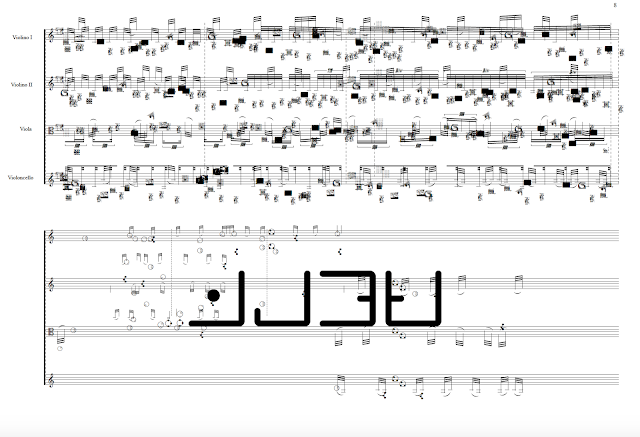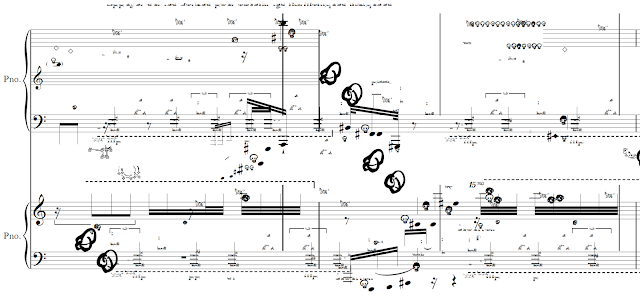Monday, March 27, 2017
Friday, March 24, 2017
Thursday, March 23, 2017
“5900+ pages of a score?…
“5900+ pages of a score?…
Do you ever recognize something you have created does not fit?”
I do. Many things. I suppose some think that you look at your oeuvre and then throw it all in the mix. And, that may not be a bad thing. Unfortunately, I don’t quite work that way (but perhaps I should explore that recipe).
I sort of thought this may have been on tap from a very astute and wise group of student composers, so I did plan ahead.
Here is a fraction of what I discarded because indeed it did not work in the context of “Partitions: Cambics Alive in Sensient Amplules”. Not to say it is irrelevant, just not part of this project.
4'33": As The Source
Huyghe’s Partition takes 4'33" as its source, its procedure recalls a different Cage composition altogether. To produce his 1952 Music for Piano, Cage scrutinized an ostensibly blank sheet of manuscript paper for its inevitable imperfections and irregularities, looking for chromatic variations or loci of acute topographic relief, and then marking a predetermined number of the minuscule blemishes and bumps in ink.
Overlaying a standard musical staff onto the field of the page then transformed that stochastic dispersal of dots into the related pitches of Western musical notation. Cage thus translated from the genre of drawing to the genre of music.
Following Cage’s cue, 4'33" has long been taken as the obvious intertext for the White Paintings, but I want to suggest that Music for Piano, dating from the same year, is just as closely related.
Where 4'33" restages the White Paintings as a musical performance— translating its neutral lack of intentional marking as a neutral absence of intentional sounds— Music for Piano takes as its starting point the lesson learned from the White Paintings: that seen from the right perspective, at the right distance, any ostensibly blank surface is in fact inconsistent, variable, fluctuant, and marked.
Cage may have restaged the conceptual proposition of the White Paintings with his so-called silent piece, but with Music for Piano he restages his own activity in front of those canvases, noting— and ultimately notating— the small specks on a manuscript sheet just as he had noticed the flecks of dust on Rauschenberg’s painting.
Music for Piano treats the substrate of the score as if it were a monochrome white painting, to be gazed at with the intensity of a modern art connoisseur. Even more importantly, Cage recognizes that changes in social context produce changes in media.
In more mundane circumstances, a dusty surface or an irregular page might provoke housecleaning or recycling, but under the sign of modernist abstraction, the facture of an otherwise blank surface generates visual interest, and under the sign of the musical score it generates pitch values.
Each mote and macula may be a concrete particular, unique to the moment of viewing or the particular sheet of paper at hand, but how we understand those marks (indeed, whether or not we even register them in the first place) depends on the conceptual milieu in which they occur.
Cage’s writing in Music for Piano hinges on the placement of the dots on the page, just as the placement of the page itself within a musical environment (rather than framed on the wall, or stacked on an office desk) determines its meaning. Milieux— etymologically from the Latin medius and locus, a literal “middle ground”— can be accurately translated as media.
Saturday, March 18, 2017
Friday, March 17, 2017
“Equivalent Ideation & Lost Gill-Slits” (2013) Bil Smith Composer
“Equivalent Ideation & Lost Gill-Slits” (2013) Bil Smith Composer
For Two String Quartets and Two Jazz Quintets featuring:
Quatuor Diotima - Radikant; Oliver Lake (Saxophones); Roscoe Mitchell (Woodwinds. Ideated Instruments); Bil Smith (Pocket Trumpet, Flugelhorn, Percussion); William Parker (Bass); Amina Claudine Myers (Piano); Milford Graves (Drums, Percussion, Ideated Instruments)
T’Ang Quartette; Evan Parker (Saxophones); Manfred Schoof (Trumpet); Maarten van Regteren Altena (Bass); Alt Koom (Percussion)
Han Bennink (Drums, Percussion)
Recording: Funkhaus Nalepastrasse, Berlin. March 12, 2013
The genesis of this composition emanates from my early music experiences as a free jazz trumpet player. Ornette Coleman’s Double Quartet and the seminal recording “Free Jazz”; Horatiu Radulescu’s musical treatise “Sound Plasma” and artist Mark Rothko all have a profound influence in the evolution of this work
ON SoundCloud: https://soundcloud.com/bil-smith/slits
Monday, March 13, 2017
Sunday, March 12, 2017
An Instrumentation for A New Composition Proposed by Ikea in a New Commission
Gencelecell-T Cornet in C (Adaptive K3 Pathway Tuning Slide)
Viola Teoma-Codexus (Trey Calivan, IRCAM)
Uniharp (September Florynce Tuning)
Stash Flute
7thSanctuary Ocarina
7thSanctuary Ocarina
Saturday, March 11, 2017
Sunday, March 5, 2017
Saturday, March 4, 2017
Subscribe to:
Posts (Atom)





























